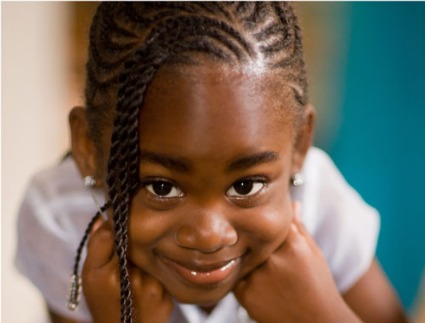
By DARLENE ROBINSON MILLENDER
My eight year-old daughter said something the other morning that made my heart skip a beat. We were in her room standing in front of the mirror while I brushed her hair into a ponytail. I’d just flat-ironed it the night before so the ponytail could be sleek. (She wants her ponytail to look like the others in her class.) My daughter had her little fingers at the corners of her mouth. She stretched her lips across her face. “Mommy, I wish my lips were this thin,” she said.
I tell you, my heart skipped a beat. I had to pause to think of my response.
It’s 1977, and I’m nine years old. I’m running around the house with what we call a “dry towel” on my head. It’s hanging down my back, and I’m using my right hand to flick it from my shoulders as I’d seen white girls in class, and Cher on TV, do. My daddy asks me what I’m doing. “I’m pretending I’m white,” I reply. Needless to say, my dashiki-wearing, Frantz Fanon-reading, and “Black Power”-espousing daddy is appalled. I don’t remember what he said after that, but I do remember the spanking I received, as if you can beat racial pride into a child. The spanking worked in a way, though; I never uttered anything remotely like that again.
But it didn’t make me appreciate my thick hair that grew outward and not downward, or the size of my lips, or the way my skirts “hiked up” in the back because of my derriere. Don’t misunderstand: I think black women are beautiful and wonderfully made; however, I did not think I possessed beauty, no matter how many people told me I did. I applaud you if you’ve always been comfortable in your skin. I, in fact, was raised by a gorgeous mom and aunt who never questioned their features. But they never shared a classroom with white students, either.
That’s right; I think integration helps to exaggerate self-esteem issues girls of color may have. I’m not the only one who thinks this. In Acting White: The Ironic Legacy of Desegregation, Stuart Buck writes that in the Brown v. Board of Educationruling, the Supreme Court pointed to the doll research done by Kenneth Clark to prove students in segregated schools were plagued with low self-esteem. But in reality, Clark’s research showed that northern black children in non-segregated schools preferred white dolls more often than black southern children. Buck states that several years after Brown v. Board of Education, one researcher conducted a study of 194 southern schools and found that black self-esteem was “lower in racially balanced schools than in predominately black schools.”
I’m not saying that integration was the start of blacks wanting to take on European features. You can look at any vintage Negro magazine or newspaper to see numerous ads for skin bleaching products and straightening combs. But I believe the reason most of these women wanted to “look white” was for survival. They wanted to present what they thought was the right look so they could get jobs, so they could eat, have a place to sleep, exist.
What I wanted was acceptance.
It’s 1974, and I’m in the first grade. I beg my daddy to cut my hair into an afro to mirror my mom’s. Much to the chagrin of my mom and grandmother, he does. When I return to school, I am met by girls and boys asking me how I got my hair like that. The braver ones even stick their hands into my ‘fro. I hear a couple of “ughs.” It takes the longest time for my hair to grow enough for pigtails.
It’s 1981, and I’m in the eighth grade. I try out for the cheerleading squad at my predominately white junior and senior high school. They want 10 girls for the squad, but only two minority girls can be selected. This is the quota. The two girls they pick are whiter looking than the rest of us.
I have become more comfortable with my looks as time has passed and old wounds have healed. And seeing my face in my daughter’s lovely face has helped, too. I have gone back to the afro, and I wouldn’t change that for anything. I want my daughter to know there is nothing wrong with her hair, or her lips, or her derriere. But I also know that getting to that knowledge can be a journey.
“Sweetheart, I want you to know you are beautiful just as you are,” I told her while sliding on her headband. “Your lips are beautiful. But I can’t make you believe that, just as your grandmother and great-aunt couldn’t make me see my own beauty. I had to come to that realization myself. Sweetheart, you may not believe me now, but I pray that one day you will.”
Darlene Robinson Millender is a writer and history lover who lives near Birmingham, Ala. with her husband and twin son and daughter. You can find more of Darlene’s work at her local history blog, The Birmingham Buff.
RELATED POSTS:
1. The Attack Against Black Girl Beauty
2. Black & Proud: How I Teach My Children to Love Their African-American Heritage
3. What Tough Girls Are Made Of
4. Loving My Milkshake & My Pearls: A #Flawless12 Celebration Of My Physical Self
Denene Millner
Mom. NY Times bestselling author. Pop culture ninja. Unapologetic lover of shoes, bacon and babies. Nice with the verbs. Founder of the top black parenting website, MyBrownBaby.
- Web |
- More Posts





So wonderfully written and so important. My daughter just cut off her hair at 12 years old. She is having a hard go of it at school. Some want to call her a boy. Others just ask, “Why?” She likes her short. She had long locs for many years. We started locking at age 3 and she had them until she was 8 and then we started braiding. She got picked on not by white children, but our children of color. “Oooh She’s just trying to be white cause black girl don’t got long hair like that.” was what had been said. It hurt, but it hurt even more because of who it came from. Anyway she is doing little twist now and she is loving it. It only takes a few minutes to do her hair in the am and she is off to school. In the summer instead of it taking days for locs to dry she is dry in less than 20 minutes. I tell her every single day how special and beautiful she is. I was often called ugly and skinny and then as I gained weight, fat and black. I have embraced the me that I am and I want so badly for all little girls to be given the chance to hair loving words about their skin and hair and bodies. That they don’t have to have lighter skin and longer hair to be beautiful. They just have to love what God has crowned them all with. Thanks so much or sharing your story with us.
I have the same issue with my daugher, including the part about recognizing those feelings from my own childhood. What I did was spend time looking and looking at different kinds of faces (looking through National Geographics magazine and so on) and really trying to SEE what was beautiful about them. And after a while it worked. Where as before I could only see the white form of beauty, eventually I was able to see beauty in all sorts of different racial characteristics. But I don’t really know how to give that to my daughter. I get “diverse” books and so on, but I don’t think its enough. I know it’s not from what she says. Your ending is interesting to me, i.e. your acceptance that you may not be able to tell her, and that she’ll have to find out for herself.
Thank you for the article.
This article brought back a memory from childhood when my maternal grandfather said my younger sister and I would be prettier if we had good hair. My mom did not appreciate that remark and rebuked her father. I guess he was hoping my sister and I had inherited my father’s wavy hair.
Thank you for your heartfelt post, Darlene. Stay encouraged. I shared your post on Facebook with the following comments: “My heart skipped a beat, too, reading this mother’s account of what every parent probably goes through in some way, shape or form. Then I sighed and thought about my own child’s concerns about her amazing hair and my decades-long self-acceptance roller coaster ride. Then I prayed for my daughter, myself, the writer, her daughter and anyone else on the path to self-love or guiding a young person along that journey. #ItAintEasySometimes”